- What is Retail?: Definition & Key Considerations
- Importance of the Retail Industry
- Characteristics of Retail
- Functions of a Retail Business
- Types of Retail Business
- Types of Retailers
- Changing Shape of the Retail Industry
- Trends in the Retail Industry
- Top Global Retailers
- Top Retailers from India
- Conclusion
- Frequently Asked Questions (FAQs)
What Is Retail & How Does It Work? Demystifying The Vital Component Of Economy
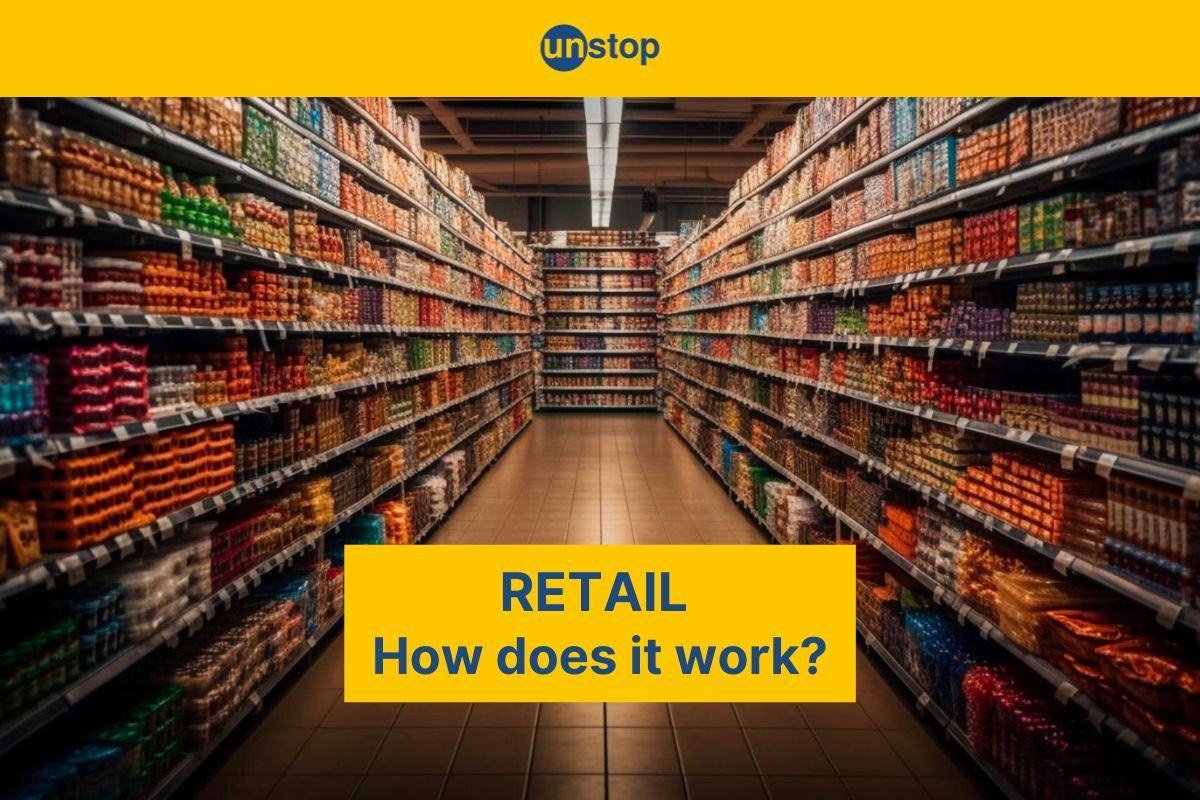
Ever wonder what goes on behind the scenes at your favorite store? Do you know what is retail? Retail is like the middleman between us, the consumers, and the products and services that we require. It not only drives job creation but also fuels economic growth.
Retail businesses take various forms, from small local shops to large multinational chains. Understanding what retail is and how it works is essential for both consumers and aspiring entrepreneurs. In this article, we will delve into the intricacies of the retail industry.
What is Retail?: Definition & Key Considerations
Retail, simply put, is the process of selling goods or services directly to consumers. It serves as the final step in the supply chain, where products are made available for purchase by end-users. The primary goal of retail is to satisfy consumer needs and wants through effective merchandising and customer service.
Successful retailers understand various aspects that contribute to their success:
They have a deep understanding of market demand, allowing them to stock products that customers desire. By staying attuned to consumer preferences and trends, they can ensure their offerings align with what people want.
Pricing strategies play a crucial role in retail. Retailers carefully determine the right price point for their products or services based on factors such as production costs, competition, and perceived value. They aim to strike a balance between profitability and affordability for customers.
Study the concept of retail pricing in detail.
Consumer behavior is another essential aspect that retailers must comprehend. Understanding how consumers make purchasing decisions helps retailers tailor their marketing efforts effectively. By analyzing buying patterns, preferences, and demographics, retailers can create targeted campaigns that resonate with their target audience.
Retailer vs Retailing
A retailer is a business entity that sells goods or services directly to consumers. They are the final link in the supply chain before products reach the end customer. Retailing, on the other hand, refers to the overall process of selling goods or services to consumers through various channels such as physical stores, online platforms, or mobile apps.
In essence, a retailer is the entity that sells products, while retailing encompasses the entire process of selling those products to consumers.
Retailing in Supply Chain
The retail supply chain is the journey a product takes from its raw materials to your shopping basket (or virtual cart!). Here's a quick breakdown:
- Sourcing: It all starts with getting the ingredients or materials. This could involve farms growing cotton, mines extracting metals, or factories producing components.
- Manufacturing: The raw materials are transformed into finished products. This could involve factories assembling clothes, processing food, or creating electronics.
- Distribution: The finished products are shipped from factories to warehouses or distribution centers.
- Wholesaling: Wholesalers buy large quantities of products from manufacturers and then sell them in bulk to retailers. (This step might not apply to all products.)
- Retailing: Finally, the products reach stores (physical or online) where the customer can buy them!
Think of it like a relay race: each step in the supply chain hands off the product to the next stage until it reaches you. An efficient and well-coordinated supply chain is crucial for retailers to get you the right products at the right time and at the right price.
Importance of the Retail Industry
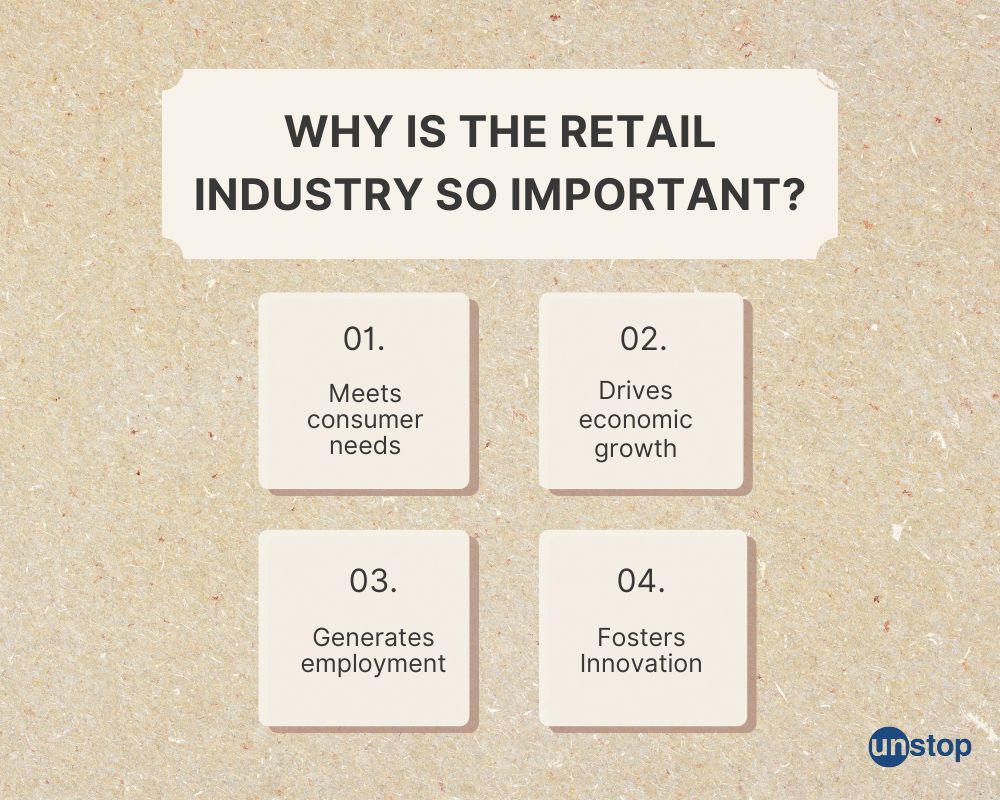
The retail industry is a vital part of our economy, providing numerous employment opportunities worldwide. It serves as a major source of income for both small businesses and large corporations, driving economic growth in the process.
Contributes to Employment Opportunities
One of the key benefits of the retail industry is its significant contribution to job creation. From sales associates and cashiers to managers and merchandisers, there are various roles available within this sector. These employment opportunities help individuals support themselves financially and contribute to their local communities.
Drives Economic Growth
The retail industry plays a crucial role in generating revenue for businesses, both big and small. By offering products and services that consumers need and want, retailers stimulate consumer spending, which in turn boosts economic growth. This revenue generation creates a ripple effect throughout the economy, benefiting suppliers, manufacturers, and service providers.
Meets Consumer Needs
Retailers are at the forefront of meeting consumer needs by providing convenience, choice, and accessibility. Whether it's purchasing groceries from a neighborhood supermarket or shopping online for clothing and electronics, retail offers consumers a wide range of options to fulfill their requirements. This variety ensures that individuals can find products that suit their preferences and budgets.
Fosters Innovation
Innovation is a crucial aspect of the retail industry as it constantly adapts to changing market dynamics and consumer demands. Retailers must stay ahead of trends to remain competitive in an ever-evolving landscape. This drive for innovation leads to improvements in product offerings, store layouts, customer experiences, and technological advancements such as online shopping platforms or personalized marketing strategies.
By embracing technology and exploring new ways to engage with customers, retailers continue to push boundaries and find innovative solutions that enhance the overall shopping experience.
Characteristics of Retail
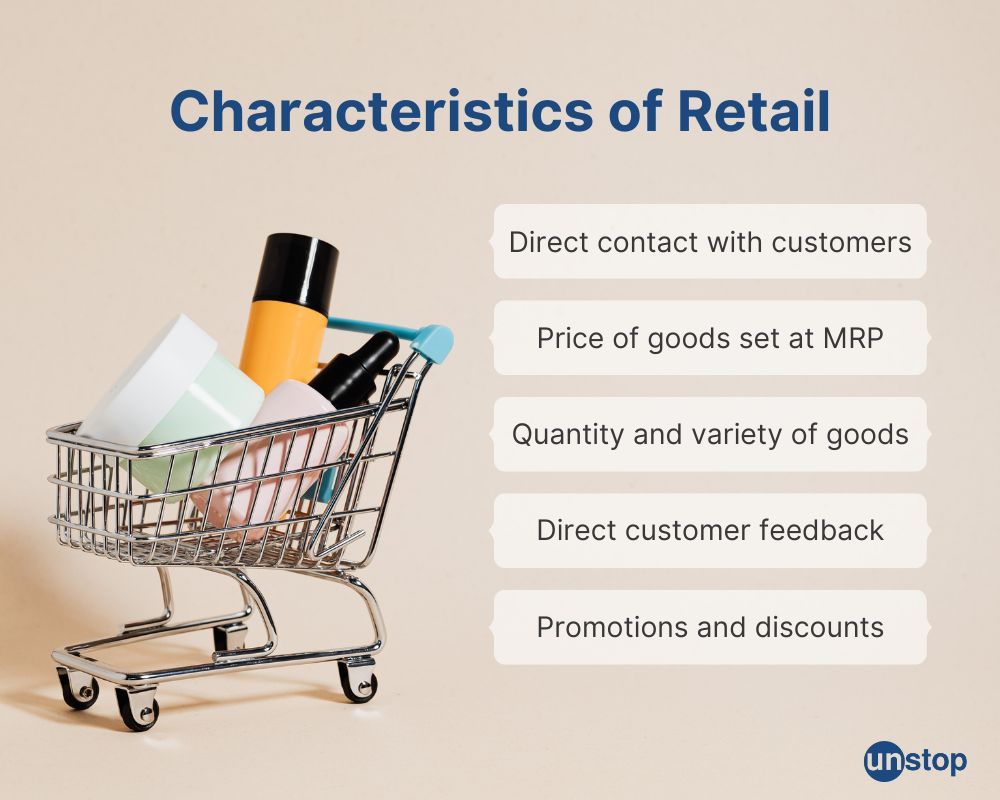
Here are the key characteristics of retail:
- Nature of contact with customers: Unlike wholesaling or manufacturing, retailing usually involves direct contact with customers. With in-store retailing, customers have the opportunity to interact face-to-face with sales associates, ask questions, and receive personalized assistance. Non-store retailing, such as online shopping or phone orders, also involves direct contact with customers through customer service representatives who can provide assistance and answer queries.
- Price of Goods: In retailing, goods are sold at the maximum retail price (MRP). Whether customers are purchasing items in-store or online, the price of goods is generally consistent and determined by the manufacturer or retailer.
- Quantity and variety of goods: Whether customers are purchasing a single item or buying in bulk, retail stores usually accommodate different quantity preferences. In-store retailing allows customers to physically select the desired quantity, while non-store retailing often provides options for customers to choose the desired quantity during the online ordering process.
- Customer feedback: Both store retailing and non-store retailing provide opportunities for customers to provide feedback on their shopping experience. In-store retailing allows customers to directly interact with sales associates and provide feedback or express concerns. Similarly, non-store retailing often includes options for customers to leave reviews or provide feedback online, which can help retailers improve their products and services based on customer input.
- Promotions and discounts: Retailing utilizes promotions and discounts to attract customers and drive sales. Retail stores often offer seasonal sales, clearance events, and promotional discounts to incentivize customers to make a purchase. Similarly, non-store retailing platforms like online shopping websites frequently provide promotional codes, flash sales, and limited-time discounts to entice customers to buy. These promotions and discounts can create a sense of urgency and encourage customers to take advantage of the savings, ultimately boosting sales for both types of retailing.
Functions of a Retail Business
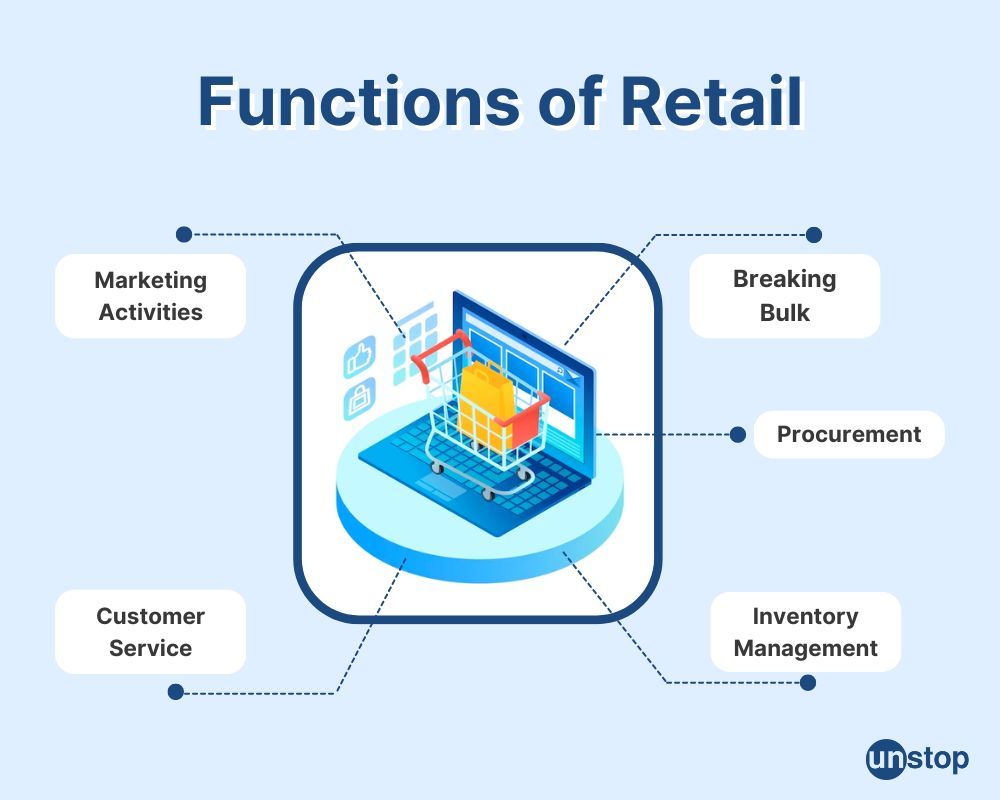
Product Sourcing or Procurement
Product sourcing or procurement involves obtaining products from manufacturers or wholesalers to sell in their stores. Retailers carefully select the products they offer based on market demand, trends, and customer preferences. By sourcing the right products, retail businesses can attract customers and meet their needs effectively.
Inventory Management
Inventory management ensures sufficient stock levels are maintained to meet customer demand without excesses or shortages. Effective inventory management involves tracking sales data, forecasting demand, and replenishing stock accordingly. By optimizing inventory levels, retailers can minimize costs, prevent out-of-stock situations, and provide customers with a wide range of choices.
Breaking Bulk
Breaking bulk is the process of purchasing goods in large quantities from manufacturers or wholesalers and then dividing them into smaller units for sale to individual customers. By breaking bulk, retail businesses are able to meet the specific needs and preferences of their customers by offering products in smaller quantities.
This function is particularly important for retailers who sell items such as food, household goods, and personal care products, as customers often prefer to purchase these items in smaller quantities that are more suitable for their immediate needs. Breaking bulk also allows retailers to manage their inventory more effectively by reducing the risk of overstocking or understocking. Overall, this function helps retail businesses to optimize their operations and better serve their customers.
Marketing Activities
Marketing activities play a vital role in the success of any retail business. Retailers employ various marketing strategies to attract customers and promote their products or services. Advertising campaigns help create awareness about the store and its offerings through channels like television, radio, print media, and online platforms. Promotions such as discounts, coupons, and special offers entice customers to make purchases. Branding efforts help establish a unique identity for the retail business in consumers' minds.
Exceptional Customer Service
Providing exceptional customer service is another important function of a retail business. When customers have positive experiences with store employees who are knowledgeable, friendly, and attentive to their needs, it enhances brand loyalty and encourages repeat purchases. Good customer service includes assisting shoppers in finding products, offering credit, answering inquiries promptly and accurately, facilitating returns or exchanges smoothly, and resolving any issues that may arise during the shopping process.
Types of Retail Business
There are two main types of retailing: store retailing and non-store retailing.
Store retailing refers to the traditional brick-and-mortar retail businesses that operate physical stores where customers can browse and purchase products. These stores can range from small local shops to large department stores and supermarkets. Store retailing allows customers to see, touch, and try on products before making a purchase, providing a tangible shopping experience. It also offers the convenience of immediate product availability and the opportunity for face-to-face interaction with sales associates.
Non-store retailing refers to businesses that do not have a physical store presence but instead sell products through other channels. This includes e-commerce websites, online marketplaces, mail-order catalogues, telemarketing, and direct selling. Non-store retailing has become increasingly popular with the rise of the internet and technology, allowing customers to shop from the comfort of their own homes. It offers convenience, a wide selection of products, and the ability to compare prices and read reviews before making a purchase. Non-store retailing also eliminates geographical limitations, allowing businesses to reach customers globally.
Here’s a comparison of the two types of retail:
| Store Retailing | Non-Store Retailing |
|---|---|
| Operate physical stores | No physical store presence |
| Allows customers to see, touch, and try on products | Customers shop from the comfort of their own homes |
| Immediate product availability | Wide selection of products |
| Face-to-face interaction with sales associates | Ability to compare prices and read reviews |
| Geographical limitations | Reach customers globally |
Types of Retailers
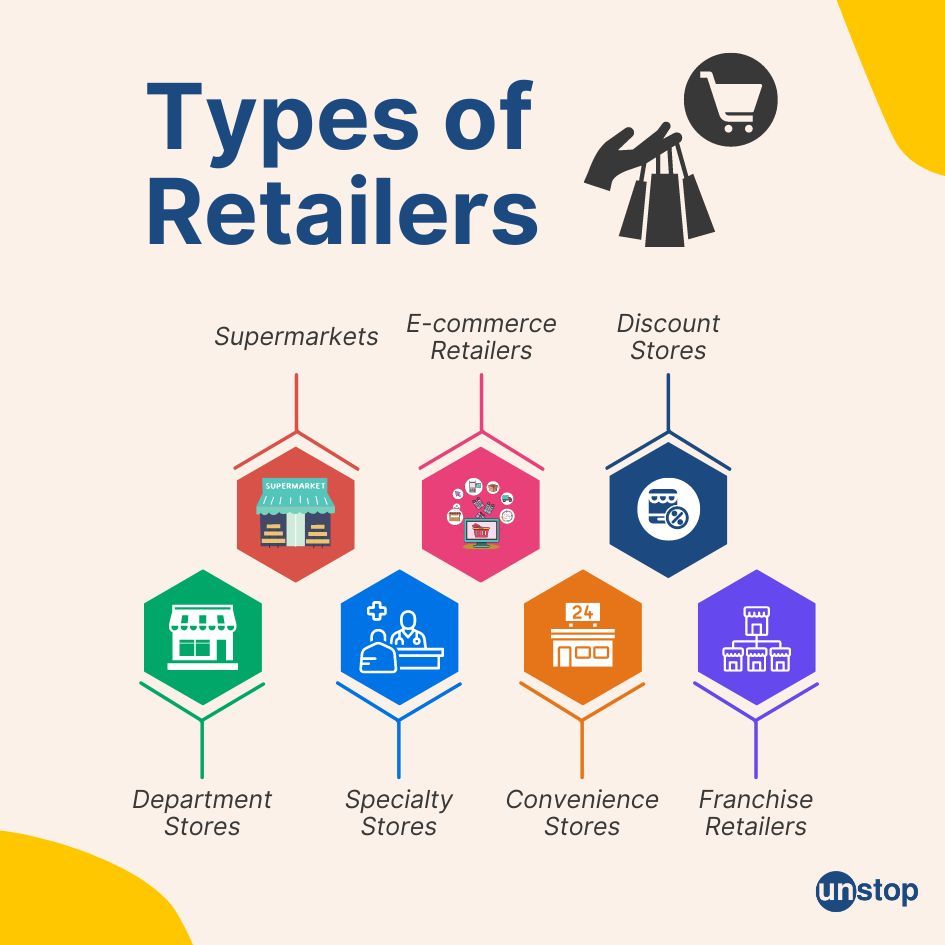
Now that we’re aware of retailing, let's dive in and explore the different types of retailers that fall under these categories.
Department Stores
Department stores are large-scale retailers that offer a diverse range of product categories all under one roof. They are like a one-stop shop for customers looking for clothing, accessories, home goods, electronics, and more. These stores often have multiple departments within them, each focusing on a specific category. For example, you might find a department dedicated to women's clothing or another focused on home appliances.
Specialty Stores
Specialty stores are retail businesses that focus on specific product categories. They cater to customers who have a particular interest or need in mind. Examples of specialty stores include electronics stores that exclusively sell gadgets and tech accessories or sporting goods stores that specialize in equipment for various sports activities. By narrowing their offerings, specialty stores can provide expert knowledge and a wide selection within their chosen niche.
Supermarkets
Supermarkets are grocery stores where people can find daily essentials and perishable goods. These establishments typically carry a wide range of food items such as fresh produce, meat, dairy products, canned goods, and household supplies. Supermarkets aim to provide convenience by offering everything customers need for their day-to-day lives in one location.
Convenience Stores
Convenience stores are small-scale shops that offer quick and easy access to everyday items. They're usually open 24/7 and stock essential products like snacks, beverages, toiletries, tobacco products, and sometimes even basic groceries. Convenience stores cater to customers who need something urgently or don't want to make a trip to a larger store.
E-commerce Retailers
In today's digital age, e-retailing has gained immense popularity. E-retailers are online platforms that enable consumers to shop from the comfort of their homes using computers or mobile devices. E-commerce retailers offer a wide range of products, from clothing and electronics to home decor and beauty items. They provide convenience, often with the option for doorstep delivery, making it easy for customers to browse and purchase items with just a few clicks.
Discount Stores
Discount stores are retail businesses that offer products at lower prices than traditional stores. These stores focus on providing affordable options to budget-conscious shoppers. By offering competitive pricing, discount stores attract customers who want to save money without compromising on quality. Examples of discount retailers include dollar stores or outlets that sell discounted branded merchandise.
Franchise Retailers
Franchise retailers operate under a recognized brand name through franchising agreements. Franchising allows small businesses to benefit from an established brand's reputation and support system while maintaining some level of independence. Franchisees can open their own store location and tap into the brand's customer base, marketing strategies, and operational guidelines.
Changing Shape of the Retail Industry
The retail industry is a vast landscape that encompasses various businesses, each offering a diverse range of products or services. From fashion and electronics to groceries and home improvement, the retail sector caters to the needs and wants of consumers in numerous markets.
With technological advancements and shifting consumer preferences, the retail industry has undergone significant transformations in recent years. One notable change is the rise of e-commerce, which has emerged as a major player in the retail market. Online shopping platforms have challenged traditional brick-and-mortar stores by providing convenience, competitive pricing, and an extensive product selection.
Technological Advancements
Technological advancements have revolutionized the way retailers operate and interact with customers. The integration of digital solutions has streamlined processes within the retail supply chain, enhancing efficiency and improving customer experiences. Here are some key technological advancements that have impacted the industry:
- Point-of-sale (POS) systems: These computerized systems enable retailers to process transactions quickly and accurately while also managing inventory effectively.
- E-commerce platforms: Online marketplaces allow retailers to reach a global audience, expanding their customer base beyond geographical boundaries.
- Mobile apps: Retailers have embraced mobile apps as a means to engage with customers directly, providing personalized offers, loyalty programs, and convenient shopping experiences.
- Data analytics: By leveraging data analytics tools, retailers can gain valuable insights into consumer behavior patterns, enabling them to make informed business decisions regarding inventory management, pricing strategies, and marketing campaigns.
Changing Consumer Preferences
Consumer preferences play a crucial role in shaping the retail industry. As lifestyles evolve and trends emerge, retailers must adapt to meet these changing demands. Here are some factors influencing consumer preferences:
- Convenience: Consumers value convenience more than ever before. They seek hassle-free shopping experiences that offer fast delivery options like same-day or next-day shipping.
- Sustainability: Increasingly conscious about environmental issues, consumers gravitate towards brands that prioritize sustainability practices and offer eco-friendly products.
- Personalization: Customized experiences resonate with consumers, who appreciate tailored recommendations and personalized offers based on their preferences and shopping history.
Impact on Traditional Retail
The rise of e-commerce has disrupted the traditional retail landscape. While brick-and-mortar stores continue to thrive, they face challenges competing with online retailers. However, there are still advantages to shopping in physical stores:
- Tangible experience: In-store shopping allows customers to physically examine products before making a purchase decision.
- Immediate gratification: With traditional retail, consumers can take their purchases home immediately instead of waiting for delivery.
- Social interaction: Shopping at physical stores provides an opportunity for social interaction and personalized assistance from sales associates.
Trends in the Retail Industry
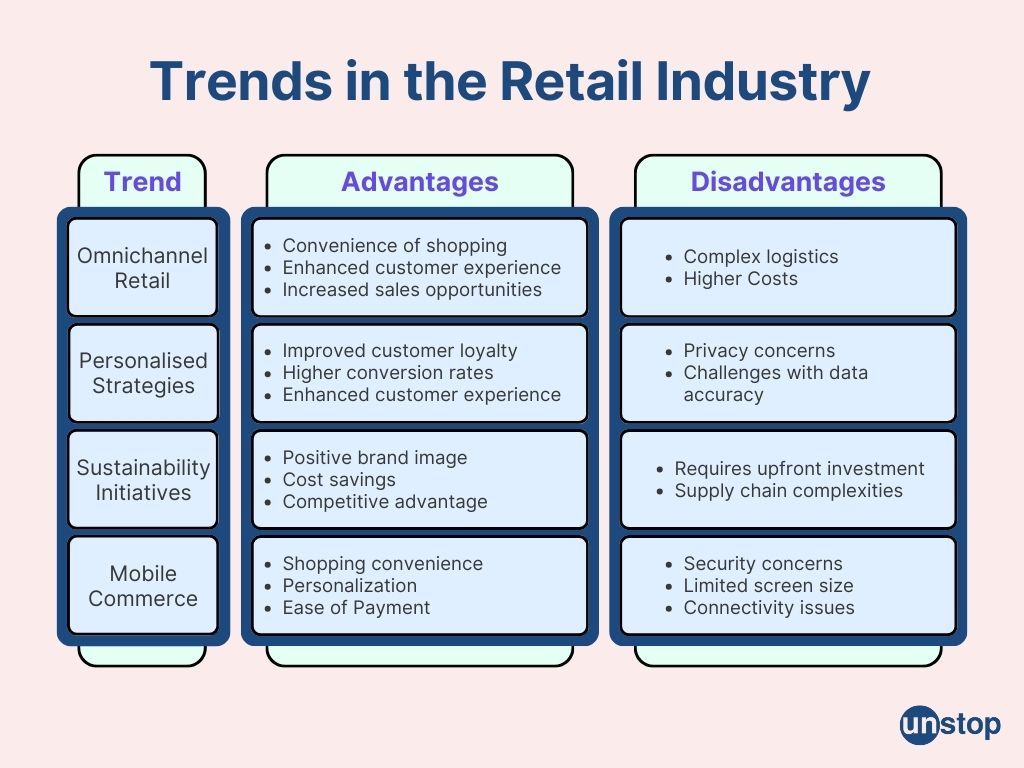
The retail industry is constantly evolving, driven by changing consumer preferences and advancements in technology. Let's explore some of the key trends that are shaping the sector.
Rise of Omnichannel Retailing
Omnichannel retailing has become increasingly popular as consumers seek seamless shopping experiences both online and offline. This trend involves businesses integrating their online and physical stores to provide a cohesive experience for customers. With omnichannel retailing, shoppers can browse products online, make purchases through various channels, and even have the option to pick up items in-store or have them delivered to their doorstep.
Pros and Cons
| Pros | Cons |
|---|---|
| Convenience: Customers have the flexibility to choose how they want to shop. | Complex logistics: Managing inventory across various channels can be challenging. |
| Enhanced customer experience: The integration of different channels allows for a more personalized and consistent shopping journey. | Higher costs: Establishing an omnichannel presence requires investments in technology and infrastructure. |
| Increased sales opportunities: Businesses can reach customers through multiple touchpoints, increasing the chances of making a sale. | - |
Personalization Strategies
Retailers are adopting personalization strategies to cater to individual customer preferences. By leveraging data analytics and AI technologies, businesses can gather insights about their customers' shopping habits, preferences, and purchase history. This information enables retailers to offer tailored recommendations, discounts, and promotions that resonate with each customer.
Pros and Cons:
| Pros | Cons |
|---|---|
| Improved customer loyalty: Personalized experiences make customers feel valued and understood. | Privacy concerns: Collecting personal data raises privacy issues that must be addressed transparently. |
| Higher conversion rates: When shoppers receive targeted recommendations based on their interests, they are more likely to make a purchase. | Data accuracy challenges: Retailers need reliable systems to ensure accurate data collection and analysis. |
| Enhanced customer satisfaction: Tailored offers create a positive shopping experience that encourages repeat business. |
Sustainability Initiatives
The retail industry is increasingly focusing on sustainability initiatives to reduce its environmental impact. Retailers are adopting eco-friendly practices, such as using renewable energy sources, reducing packaging waste, and promoting ethical sourcing of products. By aligning with sustainable values, businesses can attract environmentally conscious consumers and contribute to a greener future.
Pros and Cons:
| Pros | Cons |
|---|---|
| Positive brand image: Sustainability efforts resonate with consumers who prioritize eco-friendly practices. | Initial investment: Transitioning to sustainable practices may require upfront investments in infrastructure and processes. |
| Cost savings: Implementing sustainable practices can lead to reduced energy consumption and lower operational costs in the long run. | Supply chain complexities: Ensuring ethical sourcing throughout the supply chain can be challenging for retailers. |
| Competitive advantage: Being environmentally responsible sets retailers apart from their competitors. | - |
Mobile Commerce (M-commerce) Growth
With the widespread use of smartphones, mobile commerce has experienced significant growth in recent years. Consumers are increasingly using their mobile devices for product research, price comparison, and online purchases. This trend has prompted retailers to optimize their websites and develop user-friendly mobile apps to provide a seamless shopping experience on smaller screens.
Pros and Cons
| Pros | Cons |
|---|---|
| 1. Convenience: Mobile commerce allows consumers to shop anytime and anywhere, making it convenient for busy individuals. | 1. Security concerns: Mobile devices can be vulnerable to security breaches and hacking, putting sensitive information at risk. |
| 2. Personalization: Mobile apps can provide personalized recommendations and offers based on user preferences and browsing history. | 2. Limited screen size: The smaller screen size of mobile devices can make it challenging to view product details and compare options. |
| 3. Easy payment options: Mobile commerce offers various payment methods, including digital wallets and mobile payment apps, making transactions quick and hassle-free. | 3. Connectivity issues: Mobile commerce relies on internet connectivity, and poor network coverage or slow internet speeds can disrupt the shopping experience. |
Top Global Retailers
There are several major players that dominate the global market. Let's take a closer look at the top retailers worldwide and in India:
Walmart
Walmart is known as the world's largest retailer in terms of revenue. With its extensive network of department stores and supercenters, Walmart offers a wide range of products, from groceries to electronics and everything in between. This retail giant has a strong presence not only in the United States but also internationally, making it a household name for millions of shoppers.
Amazon
Amazon is undoubtedly one of the most influential players in the retail industry. As an e-commerce platform, Amazon revolutionized online shopping by offering diverse product offerings and convenient delivery options. From books to clothing to electronics, you can find almost anything on Amazon's virtual shelves. Its dominance in the market has made it a go-to destination for many consumers looking for convenience and competitive prices.
Alibaba Group
Based in China, Alibaba Group is a multinational conglomerate that specializes in e-commerce, retail, internet services, and more. It operates various platforms such as Taobao and Tmall, catering to both domestic and international customers. With its vast reach and innovative business models, Alibaba has transformed the way people shop online globally.
Costco Wholesale
Costco Wholesale stands out as a membership-based warehouse club that offers bulk sales at discounted prices. By providing value through bulk purchasing power, Costco attracts both individual consumers and businesses alike. Shoppers can find a wide array of products ranging from groceries to electronics to home goods at Costco's spacious warehouses.
Walgreens Boots Alliance
Walgreens Boots Alliance is an international pharmacy chain with an extensive selection of health and wellness products. With its numerous locations across different countries, Walgreens provides easy access to prescription medications, over-the-counter drugs, beauty products, vitamins, and more. It serves as a one-stop shop for all your health-related needs.
Home Depot
Home Depot is a leading home improvement retailer that caters to DIY enthusiasts and professionals alike. With its vast selection of tools, building materials, appliances, and décor items, Home Depot has become the go-to destination for those looking to spruce up their homes. Whether you're tackling a small project or embarking on a major renovation, Home Depot has you covered.
Top Retailers from India
Reliance Retail
Reliance Retail is India's largest retailer, operating a wide range of formats including supermarkets, hypermarkets, and convenience stores. It is a subsidiary of Reliance Industries Limited, one of India's largest conglomerates. Reliance Retail offers a diverse range of products, including groceries, electronics, fashion, and more. With its extensive network of stores across the country, Reliance Retail has established itself as a dominant player in the Indian retail industry.
Future Group
Future Group is one of India's leading retail conglomerates, with a presence in various sectors such as fashion, food, and consumer goods. It operates popular retail chains like Big Bazaar, Central, and Brand Factory. Future Group focuses on providing value for money to its customers and offers a wide range of products at affordable prices. The company has a strong presence in both urban and rural areas, making it accessible to a diverse customer base.
Tata Group
Tata Group, one of India's oldest and most respected business conglomerates, also has a significant presence in the retail sector. The group operates retail chains like Westside, Star Bazaar, and Croma. Westside is a popular fashion and lifestyle store, while Star Bazaar offers a wide range of groceries and household products. Croma is a leading electronics retail chain. Tata Group's retail ventures are known for their quality products, customer-centric approach, and commitment to ethical business practices.
These retailers have made significant contributions to the retail industry by offering diverse products, competitive prices, and convenient shopping experiences. Their global presence and innovative approaches have shaped consumer behavior and set new standards in the retail landscape.
In the world of retail, success hinges on understanding customer needs and delivering exceptional value. This is the essence of retail. Retailers who prioritize this are more likely to thrive in today's competitive landscape.
Conclusion
In wrapping up, it's clear that the retail landscape is undergoing a transformative phase, driven by evolving consumer behaviors, technological advancements, and the ever-increasing competition.
Retailers who are agile, innovative, and customer-centric in their approach will not only survive but thrive in this dynamic environment. By leveraging data analytics, embracing omnichannel strategies, and creating personalized shopping experiences, businesses can stay ahead of consumer expectations and foster loyalty.
As we look to the future, the key for retailers will be in their ability to adapt to changes swiftly and efficiently, ensuring that they remain relevant and top-of-mind for consumers. The journey ahead is challenging, yet full of opportunities for those ready to embrace change and innovate continuously.
Frequently Asked Questions (FAQs)
1. What is retail?
Retail refers to the process of selling goods or services to consumers through various channels, including brick-and-mortar stores, online platforms, and direct sales. It encompasses all activities involved in bringing products to market and making them available for purchase by end consumers.
2. What are some key factors a student should consider when pursuing an MBA in retail management in India?
When pursuing an MBA in retail management in India, students should consider these factors - reputation and accreditation of the MBA program, the curriculum and courses offered, the faculty and their expertise in the field of retail management, the internship and placement opportunities provided by the program, and the location and industry connections of the business school.
Additionally, students should also consider the cost of the program, the duration of the course, and the potential return on investment in terms of career prospects and salary growth.
3. How can I stay competitive in the rapidly evolving retail landscape?
To stay competitive in today's dynamic retail landscape, it is crucial to embrace technology and adapt to changing consumer behaviour. This may involve implementing e-commerce solutions for online sales channels, leveraging data analytics for better decision-making and personalized marketing campaigns, offering omnichannel experiences that seamlessly integrate offline and online shopping experiences for customers, providing exceptional customer service both online and offline, and staying updated with emerging trends in your specific niche.
4. What are some effective strategies for driving foot traffic to a retail store?
Driving foot traffic to a retail store requires a combination of marketing efforts and creating an enticing in-store experience. Some effective strategies include running targeted advertising campaigns, utilizing social media platforms to engage with potential customers, hosting events or workshops related to your products or industry, offering exclusive promotions or discounts, collaborating with complementary businesses for cross-promotion, and ensuring that your store's exterior and interior design are visually appealing and inviting.
5. What are the types of retail?
Retail is broadly divided into two types: store retailing and non-store retailing. Based on factors such as the nature of the products sold, the size of the retail operation, and the distribution channels used, retail can be further categorized into various types. Common types of retail include department stores, specialty stores, supermarkets, convenience stores, e-commerce retailers, and direct selling.
6. What is the role of retailers in the supply chain?
Retailers play a crucial role in the supply chain by connecting manufacturers or producers with end consumers. They act as intermediaries who purchase goods from wholesalers or directly from manufacturers, stock them in inventory, and sell them to consumers at a markup.
7. How do retailers make a profit?
Retailers generate revenue by selling products or services to consumers at a price higher than the cost at which they acquired them. The difference between the selling price and the cost price, known as the markup or gross profit margin, contributes to the retailer's profit after accounting for operating expenses.
8. What are some examples of retail businesses?
Retail businesses encompass a wide range of industries and sectors, including apparel and fashion, electronics, groceries, home goods, health and beauty, automotive, and entertainment. Examples of retail companies include Walmart, Amazon, Target, Macy's, Best Buy, and Starbucks.
Suggested Reads:
- Retail Management Decoded: Find Its Meaning, Importance, Benefits & Types
- Brand Personality: Definition, Significance, Business Model & Examples
- Brand Awareness A To Z: Comprehensive Guide For New Businesses
- Brand Equity: Definition, Importance, Key Elements & Examples
- Brand Management: Definition, Strategies, Principles & Benefits Explained
Alekhya Chakrabarty is a father, a doodler, a trivia buff, a sports fanatic and a lifelong student of marketing. Alekhya is the VP of Marketing & Growth at Unstop, the engagement and hiring platform which connects students and graduates with opportunities. He has over a decade and a half of experience in driving revenue and building brands with the likes of Nestle, HUL and ITC. He is an alumnus of IMT Ghaziabad and in his last stint he was leading the marketing function at Sunstone, a higher education startup. Alekhya has been recognised as a ‘Top Voice’ on LinkedIn for Digital Marketing & Brand Management. He runs a marketing podcast titled East India Marketing Company to drive conversations around growth, content, culture and commerce.
Login to continue reading
And access exclusive content, personalized recommendations, and career-boosting opportunities.
Subscribe
to our newsletter
















Comments
Add comment